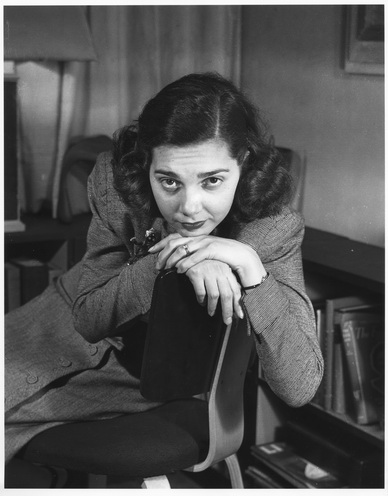 Photograph by Newson Shewitz |
Phyllis Sloane | |
| Birth Date: September 27, 1921 |
||
| Death Date: May 26, 2009 Artist Gallery |
||
| Phyllis Sloane was born in 1921 in Worcester, Massachusetts, and later moved to Cleveland. She earned a BFA in Industrial Design from the Carnegie Institute of Technology in Pittsburgh, Pennsylvania, afterward using her newfound knowledge to go freelance and then co-found the industrial design firm PDA (Packaging, Design, and Advertising).
In 1949, after the birth of her first child and tired of design, she left her company to focus on raising her family. With her career in design behind her, she turned her focus to her interest in art, joining a life drawing group alongside other female artists. In her new artistic role, Sloane faced a challenge familiar to many — balancing her career with her responsibilities as a parent. Speaking poignantly on the subject, she said, “It was very much a problem and I’ve seen it in other women artists who have [young] children. I used to feel guilty all the time because I never stopped working, and guilty about things I should be doing around the house. I had a feeling for a number of years that no matter what I was doing, I should be doing something else.” Though she often struggled to find balance, she managed to include her children in the work she created, bridging the gap between her two roles.
In 1959, Sloane shifted her artistic focus when she taught herself to operate and rebuild a broken printing press that a friend had gifted her. Having no experience in printmaking, she explored various techniques such as wood and linoleum cuts, and became well-versed in silkscreen, lithography, etching monotype, cork prints, and electrostatic copier/heat transfer printing. She developed her own style and earned a reputation for her fiercely independent printmaking, creating over 300 prints in the next forty years. She also painted, primarily in the water-based mediums of watercolor and acrylic, with these paintings mimicking her prints.
Acclaimed for sharpness and precision, two-dimensional forms with crisp silhouettes, and broad blocks of bold colors, Sloane’s style was very distinct. Many of her works are reductive, incorporating flat shapes and lacking shadows and three-dimensional modeling, as if everything were cut from sheets of paper. Speaking on her creations, Sloane stated, “I find a great deal of satisfaction in a balanced composition and in a strong, clear, well-defined image.” Her foundation in industrial design was a formative experience for her that greatly influenced her art, specifically in her inclusion of busy fabric patterning and ability to create striking forms and compositions that reflect the slick style of advertising.
Sloane focused on the female figure with the rise of the Pop Art movement, exhibiting a whimsy and playfulness through line and color. While her work often coincides with traits of Pop art, her style is very much her own, carving her own path within the movement. The women she depicted defy sexual connotation and reject the male gaze, opposing the male-driven objectification of women in Pop art. Instead, she often depicted women with strong leading roles in their lives who worked to change the status of women in society.
Sloane’s figures are solitary, not interacting with objects or other figures, creating a sense that the figures themselves are inanimate parts of a still life composition. These figures are often blended into their backgrounds, further emphasizing the notion that the figure is a compositional object rather than a portrait. Using only the first names of her sitters as the titles of their portraits, they become as anonymous as the objects that surround them. This “loss of identity” in Sloane’s work relates to the Pop art fascination with fame and its fleeting status.
In the 1980s and 90s, Sloane shifted focus to objects instead of the human figure, her primary concern being the aesthetics of shape and form. At the same time, her work is very playful, in part due to the many details and surprising elements she included in many of her still lifes, such as her own reflection in a glass, or an envelope addressed to herself. There is always some element of distortion in her work, whether that be through the angle of the viewpoint, or skewed perspective. On occasion, the objects in her still lifes often appear to be suspended in space, often placed in front of a patterned surface, making them one with their background. She included a variety of objects in her still lifes, including utilitarian objects, decorative art, natural objects like shells and plants, artifacts, prints of works of art, and commercial products. Sloane was meticulously intentional with her still life arrangements, constantly adjusting the objects within them until they formed a harmonious, balanced composition.
Sloane spent most winters in Santa Fe, New Mexico, where she had a second studio. This environment greatly inspired her artistically, brightening her palette and increasing her artistic output to an impressive number of works inspired by the vastness of the landscape. She ultimately relocated to the city in 2003, where she would live until her death in 2009.
Over the course of her career, Sloane produced many still lifes, figure paintings, landscapes, and cityscapes. According to her, “It doesn’t really matter whether the subject is a figure, still life, or landscape; my real interest is in the breaking up of the space.” During her impressive career, her work was featured in 20 solo exhibitions and is currently held in many private and public collections, such as the Cleveland Museum of Art, Philadelphia Art Museum, New Mexico Museum of Fine Art, Case Western University, and Rutgers University.
|
||


